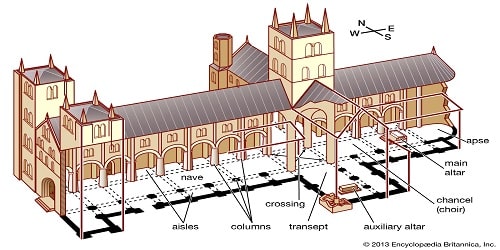Apse Meaning
The term apse belongs to the field of architecture. It is used to refer to the head section of a church, where the altar is normally located, that is, the most important part of the church. The word apse comes from the Greek apsis, meaning arch or vault, and the name was chosen for this section of the church because religious buildings of this type normally had an arch-shaped head, although this design may have changed over time.
The first religious buildings for Christianity were inspired by classical constructions such as those of Greece and Rome, in which the interior of the temple opened onto a long corridor at the end of which was located a statue of the reigning god in that house. The Christian churches and basilicas of the late Roman Empire and the first stage of the Middle Ages followed this location, which could vary in terms of size but always had a main section where the altar was located, at the end of the corridor. This section was then known as an apse. The most common shape for the apses of Christian churches was the semicircle, a typical design of the Romanesque style. However, with the passage of time and the development of other artistic styles of architecture, this format could vary towards square, rectangular, polygonal, etc. shapes.
Another typical or traditional characteristic of the apse is that it usually maintains a vaulted shape, which generates a feeling of greater connection with God and Jesus. The typical semicircular shape of the apse can be observed both from inside and outside since it stands out as part of the construction after the nave (central part or aisle) of the church. From the outside you can see its convex side. Sometimes apsidioles can be added to the apse, which are small spaces that are also vaulted and semicircular and can be located in contact with the main apse. These apsidioles can fulfill aesthetic functions as well as be practical and have a specific objective.
Apse Meaning in Hindi
एप्स शब्द वास्तुकला के क्षेत्र से संबंधित है। इसका उपयोग चर्च के मुख्य भाग को संदर्भित करने के लिए किया जाता है, जहाँ सामान्य रूप से वेदी स्थित होती है, अर्थात चर्च का सबसे महत्वपूर्ण भाग। एप्स शब्द ग्रीक शब्द अप्सिस से आया है, जिसका अर्थ है मेहराब या तिजोरी, और चर्च के इस भाग के लिए यह नाम इसलिए चुना गया क्योंकि इस प्रकार की धार्मिक इमारतों में सामान्य रूप से मेहराब के आकार का सिर होता था, हालाँकि समय के साथ इस डिज़ाइन में बदलाव हो सकता है।
ईसाई धर्म के लिए पहली धार्मिक इमारतें ग्रीस और रोम जैसे शास्त्रीय निर्माणों से प्रेरित थीं, जिसमें मंदिर का आंतरिक भाग एक लंबे गलियारे में खुलता था जिसके अंत में उस घर में राज करने वाले देवता की एक मूर्ति स्थित थी। रोमन साम्राज्य के अंत और मध्य युग के पहले चरण के ईसाई चर्च और बेसिलिका ने इस स्थान का अनुसरण किया, जो आकार के मामले में भिन्न हो सकते थे लेकिन हमेशा एक मुख्य भाग होता था जहाँ गलियारे के अंत में वेदी स्थित होती थी। इस खंड को तब एप्स के रूप में जाना जाता था। ईसाई चर्चों के एप्स के लिए सबसे आम आकार अर्धवृत्त था, जो रोमनस्क्यू शैली का एक विशिष्ट डिज़ाइन था। हालांकि, समय बीतने और वास्तुकला की अन्य कलात्मक शैलियों के विकास के साथ, यह प्रारूप वर्गाकार, आयताकार, बहुभुज आदि आकृतियों की ओर भिन्न हो सकता है।
एप्स की एक और विशिष्ट या पारंपरिक विशेषता यह है कि यह आमतौर पर एक गुंबददार आकार बनाए रखता है, जो भगवान और यीशु के साथ अधिक जुड़ाव की भावना पैदा करता है। एप्स का विशिष्ट अर्धवृत्ताकार आकार अंदर और बाहर दोनों से देखा जा सकता है क्योंकि यह चर्च के नैव (मध्य भाग या गलियारे) के बाद निर्माण के हिस्से के रूप में सामने आता है। बाहर से आप इसका उत्तल पक्ष देख सकते हैं। कभी-कभी एप्स में अप्सिडियोल जोड़े जा सकते हैं, जो छोटे स्थान होते हैं जो गुंबददार और अर्धवृत्ताकार भी होते हैं और मुख्य एप्स के संपर्क में स्थित हो सकते हैं। ये अप्सिडियोल सौंदर्य संबंधी कार्यों को पूरा करने के साथ-साथ व्यावहारिक भी हो सकते हैं और इनका एक विशिष्ट उद्देश्य हो सकता है।
